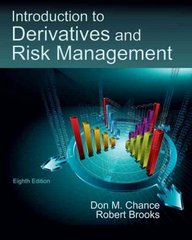Question
Question 21 (1 point) Which of the following is not a true statement? Question 21 options: Common stockholders have a residual claim to income. Bondholders
Question 21 (1 point)
Which of the following is not a true statement?
Question 21 options:
|
| Common stockholders have a residual claim to income. |
|
| Bondholders may force a corporation into bankruptcy for failure to make interest payments. |
|
| Common stockholders are legally entitled to some dividend. |
|
| A minority interest can still elect members to the Board of Directors under cumulative voting even though someone else owns 51% of the stock. |
Question 22 (1 point)
"Preemptive rights" means that
Question 22 options:
|
| existing shareholders can prevent management from issuing additional common stock. |
|
| common shareholders can "preempt" preferred shareholders for dividends. |
|
| existing shareholders are guaranteed an opportunity to retain their proportional share of ownership of the firm. |
|
| management can preempt the right of shareholders to receive dividends if earnings are down. |
Question 23 (1 point)
A rights offer made to existing shareholders with the sole purpose of making it more difficult for another firm to acquire the company is called
Question 23 options:
|
| a preemptive right. |
|
| a poison pill. |
|
| ex-rights. |
|
| rights-on. |
Question 24 (1 point)
The most important feature of the preemptive right is that the rights
Question 24 options:
|
| may be sold for profit. |
|
| afford stockholders possible protection against dilution. |
|
| may be cumulatively voted. |
|
| are nontransferable. |
Question 25 (1 point)
The computation of "basic earnings per share" will include consideration of
Question 25 options:
|
| all convertible securities. |
|
| only shares outstanding. |
|
| shares outstanding and convertible securities. |
|
| None of these options |
Question 26 (1 point)
Mirrlees Corp. has 1,000,000 outstanding shares. Compute the "basic earnings per share" if after-tax earnings are $1,400,000.
Question 26 options:
|
| $0.71 |
|
| $1.25 |
|
| $1.33 |
|
| $1.40 |
Question 27 (1 point)
The conversion ratio is the
Question 27 options:
|
| price at which a convertible security is exchanged into common stock. |
|
| ratio of conversion value to market value of a convertible security. |
|
| number of shares of common stock into which the convertible may be converted. |
|
| ratio of the conversion premium to market value of a convertible security. |
Question 28 (1 point)
A 2-for-1 stock split is declared. In this case, which of the following statements is true?
Question 28 options:
|
| The cash account declines. |
|
| The common stock account rises. |
|
| The retained earnings fall. |
|
| The par value of the common stock is reduced. |
Question 29 (1 point)
Lucas Inc. earned $15 million last year and retained $6 million. Lucas has 5 million shares outstanding, and the current price of Lucas shares is $30 per share. What is the payout ratio?
Question 29 options:
|
| 2.67% |
|
| 4% |
|
| 40% |
|
| 60% |
Question 30 (1 point)
A stock dividend will
Question 30 options:
|
| increase the total value of stockholders' equity. |
|
| decrease the total value of stockholders' equity. |
|
| not affect the total value of stockholders' equity. |
|
| change the total value of stockholders' equity but the direction cannot be determined unless the market price and par value is known. |
Question 31 (1 point)
A stock dividend will
Question 31 options:
|
| increase the value of a share of stock. |
|
| decrease the "capital in excess of par" account. |
|
| decrease the retained earnings account. |
|
| None of these options |
Question 32 (1 point)
In the initial stage (Stage I), the corporation
Question 32 options:
|
| has a product yet to be accepted in the marketplace. |
|
| anticipates rapid growth in sales and earnings. |
|
| needs all its earnings for reinvestment in new assets. |
|
| All of these options |
Question 33 (1 point)
A convertible bond is currently selling for $1,125. It is convertible into 20 shares of common stock that presently sell for $40 per share. The conversion premium is
Question 33 options:
|
| $325. |
|
| $215. |
|
| 66.74 shares. |
|
| 23.8 shares. |
Question 34 (1 point)
If the stock price rises substantially above the conversion price, an advantage to the corporation would be
Question 34 options:
|
| the premium would decrease. |
|
| the floor price would offer the investor downside protection. |
|
| the bond would most likely be converted into common stock and the debt would not have to be repaid. |
|
| None of these options are advantages to the corporation. |
Step by Step Solution
There are 3 Steps involved in it
Step: 1

Get Instant Access to Expert-Tailored Solutions
See step-by-step solutions with expert insights and AI powered tools for academic success
Step: 2

Step: 3

Ace Your Homework with AI
Get the answers you need in no time with our AI-driven, step-by-step assistance
Get Started


